
Discover Impact Factors for Sustainable Success
4 Critical steps in Developing a sustainability strategy
Every day, modern organizations face new and growing obstacles. On the other hand, sustainable businesses have proven to be more resilient. But where do you begin? What steps can be taken to take your efforts to the next level? Here are the four critical steps in developing a sustainability strategy,
Step 1: Identify the impact factors
Step 2: Determine the long-term vision and mission
Step 3: Formulate the sustainability strategy
Step 4: Implement the sustainability strategy and track success
🚀 Elevate Your Project Management Career:
– Register for my upcoming PgMP/PfMP Success Story Webinar: https://bit.ly/4bzs0U6
– Book an obligation-free consultation session on Project management Career, training, and certifications: http://talktodharam.com
– Discover training offers and certification discounts: https://bit.ly/3jWVepD
– Stay updated with our Q&A series and certification success stories by subscribing to the vCare Project Management YouTube channel at https://bit.ly/2YF0wJl
– Follow my podcasts and interviews with Project Management Experts on YouTube at https://bit.ly/2NDY8wd


Recent Comments